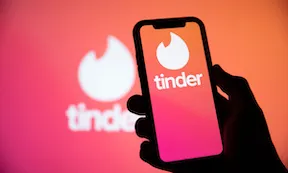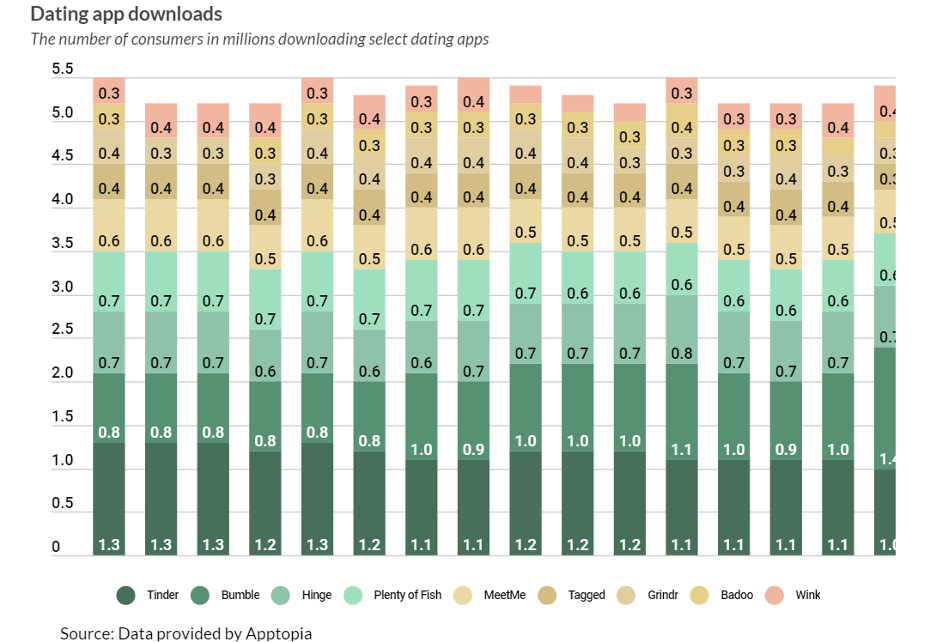15% of Consumers With Dating Apps Opt for a Paid Subscription Service

Dating apps have revolutionized the way people meet and connect. In the U.S., more than 70 million consumers log in to these apps each month, with 25 million logging in daily to search for dates, hookups and potential partners.
Tinder, Bumble and Hinge are the most popular dating apps used in the U.S., representing approximately 60% of the 60 million-plus downloads last year. The remaining 40% of downloads were driven by lesser-known apps such as Plenty of Fish, MeetMe, Tagged, Grindr, Badoo and Wink, which are steadily gaining traction.

These are some of the key findings detailed in “The Love and Social Media Edition” of the ConnectedEconomy™ monthly report series, in which PYMNTS Intelligence explores how social media is changing online dating and how consumers are using digital tools in their everyday lives.
According to the report’s findings, while dating apps provide a platform for initial connections, users are increasingly turning to social media to gather more information about potential dates. In fact, social media and dating apps go hand in hand, with 90% of dating app users also utilizing social media platforms.
Additionally, 78% of dating app users specifically use social media to check potential dates’ profiles. This trend is particularly prevalent among Gen Z consumers, with 58% of them using other apps to conduct social media profile checks on potential dates.
Examining the data further reveals that the majority of dating app users are concentrated in urban areas, with half of all urban consumers utilizing these apps. In contrast, only 19% and 16% of suburban and rural consumers, respectively, use dating apps.
In terms of gender, men are more likely than women to log in daily to dating apps or sites, with 12% of men using them daily compared to less than 8% of women. Overall, about 34% of men and 21% of women use dating apps and sites, per the study.
When it comes to age demographics, Generation Z consumers and millennials account for a significant portion of dating app users. Approximately 57% of Gen Z and nearly 50% of millennials use some form of dating app or site, surpassing other generations. Bridge millennials are not far behind, with about 42% of those surveyed using dating sites and apps.
On the other hand, older generations, particularly Generation X and baby boomers, show the lowest interest in using these platforms for meeting and connecting with individuals. According to the study, only about 20% and 4% of these demographic groups, respectively, utilize dating apps and sites.
Drilling down into the data shows that around 15% of consumers who download dating apps end up paying for subscriptions to the service. However, the subscription patterns of Gen Z and millennials are driving a shift in the membership plan strategies of app providers.
Tinder’s parent company, Match Group, announced during its third-quarter financial results last month that the app will be offering weekly subscriptions to capture the spending of younger consumers, who are typically reluctant to commit to longer-term plans.
“We’ve learned from launching weekly subscriptions, that the younger generations Tinder primarily serves have more of an affinity to lower price and shorter-term duration products that we had initially anticipated,” CEO Bernard Kim explained, per PYMNTS.
Tether Co-Founder Reeve Collins Backs New Stablecoin Project

Tether Co-Founder Reeve Collins is reportedly backing a new stablecoin project called Pi Protocol that will be backed by yield-bearing real-world assets like bonds.
The new stablecoin is expected to debut on the Ethereum and Solana blockchains in the second half of the year, Bloomberg reported Tuesday (Feb. 18).
Pi aims to let industry participants who market the stablecoin get most of the profits from it, according to the report.
The company will use smart contracts to mint its USP stablecoin and will reward the minters with another token, USI, as yield, the report said.
“We view Pi Protocol as the evolution of stablecoins,” Collins told Bloomberg. “Tether has been extremely successful in showcasing demand for stablecoins. But they keep all the yield. We believe 10 years later the market is really ready to evolve.”
Collins served as Tether’s first CEO from 2013 to 2015, when he and his partners sold the company to the operators of the crypto exchange Bitfinex, according to the report.
Tether said in January that it made $13 billion in profits in 2024, Bloomberg reported Jan. 31, adding that the stablecoin issuer files quarterly information as part of a third-party attestation by accounting firm BDO rather than issuing audited financial statements.
In addition, Tether said it issued more than $23 billion in USDT in the last three months of 2024, and had more than $7 billion in excess reserves.
It was reported in January that an executive order issued by President Donald Trump will boost stablecoins and issuers like Tether and Circle Internet Financial.
Trump’s order aligned stablecoin’s with the government’s efforts to maintain the global supremacy of the dollar and blocked a potential competitor to stablecoins by barring development of a central bank digital currency (CBDC).
On Monday (Feb. 17), Standard Chartered Bank Hong Kong (SCBHK), Animoca Brands and HKT said they agreed to form a joint venture to issue a stablecoin backed by the Hong Kong dollar.
Cedar Money said Jan. 30 that it raised $9.9 million in a seed round to support the growth of its payments software that uses stablecoins to facilitate cross-border payments between developed and emerging markets.